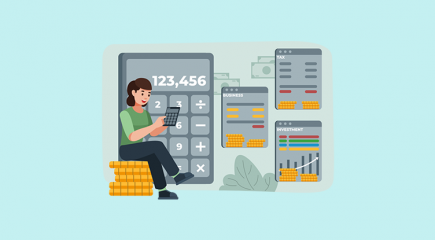The debt-to-equity ratio is a leverage ratio that compares the organization’s debt to total equity possessed. It illustrates the percentage of financing which comes from the creditors and the investors and as one of the more widely used financial ratios.
The elements used to compute the ratio are attained from the financial statements to assess the financial leverage. Unlike the debt to assets ratio, where the total assets are the denominator, the ratio uses equity. The debt-to-equity considers the capital structure.
Formula
Use the following formula to calculate the debt-to-equity ratio:
Debt-to-Equity = (Short Term Debt + Long Term Debt + Other Payments) / Total Equity
Example
Assume from the financial statements that a company’s total debt registers as $30,000, payments are $10,000, and the equity is $50,000. The debt-to-equity will be 0.8. It would mean that for every dollar from the shareholder’s equity, the organization has 80% in leverage. A ratio of 1 means creditors and the investors have an equal stance when it comes to the company’s assets. So it is completely leveraged.
Debt
During the calculation of the ratio, debt is defined as external liabilities. That means loans, current liabilities, and debentures. Including the current liability may be controversial in this setting because the ratio concerns solvency in the long term and current liabilities are used for short term evaluations.
The current liability is also known to fluctuate during the financial year. On the other hand, current liabilities are external and hold similar rights, which are to be paid out just like the long term debts in insolvency.
Generally, short-term debt is less expensive to borrow than long-term debt, while also being less sensitive to changing interest rates. If interest rates drop, it would be wise for a company to refinance its long-term debt in order to decrease its liability and increase its cash flow.
Equity
Equity may include the shares, reserves, retained profit, and accumulated losses. Including preference shares has been considered because it is similar to debt in terms of being a fixed obligation. Inclusion, though, is strengthened by the element it has ownership rights, and it does not have the preferential right of payments in the same manner as debts.
Analysis
During the use of this liquidity ratio, it is crucial to consider the overall industry in which it operates. Different industries come with various ratio benchmarks for the debt-to-equity. Some sectors prefer debt financing as a means of operation as compared to others. Generally, a bigger ratio than the industry average is deemed to be on the risky side. Industries such as banking typically have higher debt-to-equity ratios than other industries.
A debt-to-equity ratio that is low would signify that the business is financially stable. That is because it shows the total shareholder equity has a high stake in the assets than the creditors. Unlike equity financing, debt has to be given back to the one who lent it in the first place.
Since it also means debt servicing in the form of interest, debt may be seen as far more expensive than equity in financing. The companies that leverage significant amounts of debt may not ever get out of the hole and stabilize in the long run.
Creditors also see the high debt-to-equity ratio as risks because it illustrates the investors have not funded the operations in the same way as the creditors. In other words, they do not have as much skin in the game. It may indicate the investors do not want to fund these operations as the company is not performing the right way. It may also be one of the main reasons the company is looking towards additional debt financing.
Use of Debt-to-Equity for Evaluating Capital Structure
Investors tend to use the debt-to-equity ratio to assess if they will loan the business. How the company is paying for its business is important information. The lenders and investors would like to know if their revenue is being put to good use and if they are going to get a good return on the investment. Should the debt to ratio increase, the lender may feel there is a higher risk over time and decide not to proceed with lending.
It is also used to assess the competition. Businesses can benefit from knowing their debt-to-equity fares better or worse than others in the same industry. As the markets continue to fluctuate and go through changes, management can gain an advantage by understanding where they stand relative to the biggest competitors.
It also provides an idea of whether it would be advisable to take on more debt levels, thereby pushing for investments in new projects. Businesses would benefit from knowing how day-to-day decisions affect the debt-to-equity ratio.
That knowledge may affect the other financial elements of the firm. The cash flow’s accounts payable and receivable would influence the final debt to ratio figure. That would impact the way the capital structure is seen in the eyes of the shareholders.
Advantages
The debt-to-equity ratio allows the owner to regulate the debts and retain control over their business with limited capital. The shareholders can also enjoy higher returns on equity as the total returns would be divided into very few hands. It also shows the advantages of equity over credit.
It may be the only way to fund financial growth. Equity financing does not take revenue out of the company, while debt repayments are quite risky as they take money from the small business, thereby reducing the cash flow.
Disadvantages
There is ambiguity when it comes to computing debt using leverage ratios. Debts can be thrown around as if they indicate the same thing, but they do not. All debts are liabilities though not all liabilities qualify as debt. Debts may be short term, whereas the liabilities are seen as company debt obligations that come during business activities.
Due to ambiguities, when it comes to understanding the terms, the balance sheet may have individual accounts that are not seen as debt or equity within the asset’s book value. They are also inconsistent.
Preferred stock may be termed as equity sometimes though the preferred dividend, liquidation, and par value rights make it seem like debt. Preferred stock in the total liabilities would increase the debt-to-equity ratio. So it would make the business seem too risky for investors.


